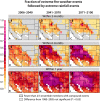Climate change increases risk of extreme rainfall following wildfire in the western United States
- PMID: 35363525
- PMCID: PMC10938567
- DOI: 10.1126/sciadv.abm0320
Climate change increases risk of extreme rainfall following wildfire in the western United States
Abstract
Post-wildfire extreme rainfall events can have destructive impacts in the western United States. Using two climate model large ensembles, we assess the future risk of extreme fire weather events being followed by extreme rainfall in this region. By mid-21st century, in a high warming scenario (RCP8.5), we report large increases in the number of extreme fire weather events followed within 1 year by at least one extreme rainfall event. By 2100, the frequency of these compound events increases by 100% in California and 700% in the Pacific Northwest in the Community Earth System Model v1 Large Ensemble. We further project that more than 90% of extreme fire weather events in California, Colorado, and the Pacific Northwest will be followed by at least three spatially colocated extreme rainfall events within five years. Our results point to a future with substantially increased post-fire hydrologic risks across much of the western United States.
Figures







References
-
- Kean J. W., Staley D. M., Forecasting the frequency and magnitude of postfire debris flows across Southern California. Earths Future 9, e2020EF001735 (2021).
-
- Ebel B. A., Martin D. A., Meta-analysis of field-saturated hydraulic conductivity recovery following wildland fire: Applications for hydrologic model parameterization and resilience assessment. Hydrol. Process. 31, 3682–3696 (2017).
-
- Oakley N. S., Cannon F., Munroe R., Lancaster J. T., Gomberg D., Martin Ralph F., Brief communication: Meteorological and climatological conditions associated with the 9 January 2018 post-fire debris flows in Montecito and Carpinteria, California, USA. Nat. Hazards Earth Syst. Sci. 18, 3037–3043 (2018).
-
- J. Kershner, Carlton Complex Fire. HistoryLink.org (2014); www.historylink.org/File/10989.
-
- D. M. Staley, E. G. Joseph, J. W. Kean, Objective definition of rainfall intensity- duration thresholds for post-fire flash floods and debris flows in the area burned by the Waldo Canyon fire, Colorado, USA, in Engineering Geology for Society and Territory—Volume 2: Landslide Processes, G. Lollino, D. Giordan, G. B. Crosta, J. Corominas, R. Azzam, J. Wasowski, N. Sciarra, Eds. (Springer International Publishing, 2015), vol. 2, pp. 621–624.

